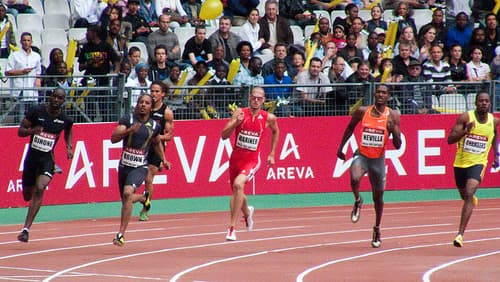Author: Jimson Lee

For several decades, I used a specific formula to calculate the 400 meter potential of elite sprinters.
The formula is:
400m potential = 200m Season Best (SB) doubled, plus 4 seconds.
Note that I used Season Best, and not Personal Best, because a time from a previous year may show a huge difference (for better or worse).
For a 44 second world class sprinter, a 20 second 200 meter SB means (20 x 2) + 4 = 44 seconds.
A collegiate sprinter may be able to run a 21 SB, so (21 x 2) = 46 seconds.
And in my case, it was a 22 SB, so (22 x 2) + 4 = 48 seconds.
So what was wrong with my equation?
What if you want to break 60 seconds for the 400 meters? To break 60 seconds means you would need a 28 second SB (28 x 2 + 4 = 60), right? Wrong.
There is a major flaw in this equation because there is a huge difference between a world class 44 second runner, a 50 second junior college runner, or someone (like Tim) attempting to break 60 seconds.
The flaw: that extra 4 seconds is always fixed regardless of the 200m speed.
The actual slowdown for most non-elite 400m runners is about 9% from their best 200 meter time.
Therefore, if you are trying to break 60 seconds, you need to be able to run a 27.5 second 200m or better as (27.5 x 2) x 1.09 = 59.95 seconds.
And if your best 200m run is 40 seconds, for example, you could expect to run the 400m in about 87 seconds – my previous formula would have predicted a time of 84 seconds which probably isn’t realistic.
It all comes down to speed.
The bottom line in this formula is speed and speed reserve, and of course, speed endurance. The faster your 200m time, the faster your 400m potential, assuming the training is in place, proper race execution, and being injury free.
Your 200m potential is based on your 100m time, and your 100m time is based on your 60m time.
Roughly, your 200m time should be 2x your 100m time. Your 100m will be approximately 1.53x your 60m time.
Working backwards, you can take your 60 meter time, which will hurt a lot less than a 400m (trust me on this!) and calculate 100m, 200m and 400m potential.
What is Speed Endurance Training?
The purpose of speed endurance training is to prolong the amount of time where a near maximal speed can be maintained.
Although the term is aimed at the long sprinters (200m-400m), speed endurance training also benefits the longer distance runners as well as other events like hockey.
The training range for sprinters will usually be runs between 7 and 40 seconds where there is nearly complete recovery between each of the runs (especially if the runs are near 95% of maximum speed). A sample workout would be 2 x 300m or 325m with a full 15-20 minute recovery. Note: Running events up to 7 seconds utilizes the ATP/CP energy stores, and anything over 40 seconds is considered aerobic, or a mixture of anaerobic & aerobic, depending on the intensity.
Longer distance runners also benefit from speed endurance training. For example, an 800m runner would do intervals at a distance less than 800m (i.e. 400m repeats) at a speed of race pace or faster. Similarly, a marathon runner would do 1-mile or 1-kilometer repeats at race pace or faster speeds.
Keeping relaxed is the key to maintaining proper form throughout, especially keeping the hips as high as possible. I like to imagine someone pulling and holding my hair up (like a Bugs Bunny cartoon) and enforcing the term “keep tall & relaxed.”
So, can someone with a personal best of 11.54 seconds for the 100 meters run a world record time in the 400m of 43.18 seconds?
In theory, it’s possible.
11.54 seconds is about 10.54 seconds if you take in account 1 second for acceleration out of the blocks. This translates to an average speed of 9.48 meters per second (m/s), or about 42.18 seconds for 400m. Add 1 second for acceleration, and voila, you have 43.18 seconds!
So when a young lad shows up at the track with a personal best of 11.30 seconds, I tell him, “Son, if you ran your 100m, kept going for 400m, and don’t slow down, you would break the world record!”
It’s not as simple as that, but it illustrates the importance of speed endurance.
